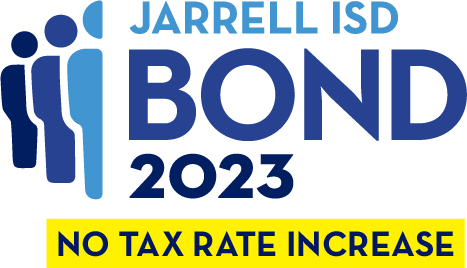
TAX AND FINANCIAL INFORMATION
NO CHANGE TO DISTRICT TAX RATE
Taxpayers will not see an increase to the school district tax rate if voters approve the bond proposal on the May 6, 2023 ballot.
How is Jarrell Able to Issue New Bonds Without Increasing the Tax Rate?
The main reason the district can issue new bonds without increasing the I&S tax rate is due to rapid growth in the community. As new homes and businesses are built, those are added to the districts Taxable Assessed Value (TAV). The amount of taxes levied by Jarrell ISD are calculated by multiplying the district’s tax rate by the taxable value of the property within the district. As commercial and residential development continues to grow in Jarrell, so does the taxable assessed value.
Any change on a resident’s tax bill would come from a change in property value which is set by the Williamson County Appraisal District, not Jarrell ISD.
However, a new state law now requires every school district to include the statement “THIS IS A PROPERTY TAX INCREASE” on the ballot, regardless of the actual impact on that district’s tax rate. As a result, voters will see this language on the bond proposition, even though Jarrell ISD’s tax rate would not increase.
VOTERS OVER 65
For residents 65-years and older, their school district tax bill will not increase, even if their property values increase (excluding property improvements) as long as an approved Homestead and Over-65 Exemption application is on file with the Williamson Central Appraisal District, and the property has been owned as of Jan. 1 of the tax year.
The over-65 population pay what is termed frozen taxes. Meaning, the amount of school taxes paid when they turn 65 will be the same, frozen amount every year thereafter.
Understanding the School Tax Rate
A school district’s budget is divided into two figures or “buckets.” The first is the Maintenance & Operations (M&O) budget, also known as the General Fund. The M&O fund is used to pay for the day-to-day operations of a district and includes items such as salaries, utilities, food, gas, supplies, etc.
The second is the Interest & Sinking (I&S) budget or Debt Service. This fund is used to repay debt for capital improvements approved by voters through bond elections. As a comparison, this fund is similar to a mortgage or home improvement loan. I&S funds may only be used to repay debt. State law caps the I&S tax rate at $0.50 in order to issue bonds. So, if this bond package is approved by voters, the District’s tax rate will not increase.
Proceeds from a bond issue can be used for the construction and renovation of facilities, the acquisition of land and the purchase of capital items, such as equipment, technology and transportation. Please keep in mind that we roughly match the weighted average useful life of the projects that are financed to the weighted average maturity of the bonds. This ensures that we repay bonds issued for shorter-term assets (such as technology) more quickly than longer-term assets (i.e., school buildings) and that the District repays for its projects over a period that is roughly the same as the useful life of those projects.
By law, I&S funds cannot be used for the M&O budget, which means voter-approved bonds cannot be used to increase salaries or to pay rising costs of utilities or services.
Jarrell ISD’s current M&O tax rate is $0.8545 and the I&S rate is $0.50, for a total district tax rate of $1.3546 per $100 of property value, 13 cents lower than it was 5 years ago. The district has continually lowered the overall tax rate over the last few years.


